Sign in to create or edit a product review. First off, let me say that I generally enjoy Rite Publishing's material. Even this product has some really good ideas, and its a good concept. I think that skills could use some more options as well. Unfortunately, while some new options really are new options, some are just begging to be abused, and others really should be feats when you look at the overall design paradigm of Pathfinder. Among the good ideas? Guidelines on bribes based on level, and what kind of information you could get from an autopsy. Great, these are things not currently addressed. Exactly what I'm looking for. Then some things get clunky. Skill uses that require you to have a minimum number of ranks in other skills seem especially cumbersome. It's not that there isn't a certain logic to it, but at the same time, it complicated and doesn't resemble other rules in the game regarding skills. Then we get into using diplomacy for calling for a truce, and other skill uses that allow for a very specific use of the skill. Too many players already get hung up on forcing NPCs to do something with social skills, and skill uses like this just encourage "diplomacy as a charm spell" gaming. Then there are skill uses that allow PCs to ignore difficult terrain (already done with other mechanics that aren't just higher DCs, and kind of messes with people that took those options), and skill uses that allow for shutting down or reprogramming constructs (definitely something I'd require a feat CHAIN for, not just a really high DC). I really wanted to like this product, and there are some good ideas in this, but it would take too much "this is in, that is out" GM editing, and would open up too many questions compared to just not using the product outright. Here's to more skill uses that are brand new ideas and not just ways to circumvent existing rules with high skill DCs. The Genius Guide to Hellfire Magic is a fun product. None of the spells presented, even with the “temptation” options of casting them as evil spells, really seem to throw them out of whack. They are evocative and fun. The domain(s) presented, as well as the witch's hex options, are similarly within what you would expect for domains or hexes within the game. I'm not sure I'd unleash this option on every game, but these make for nice thematic spells for a campaign where you want either your PCs to be tempted by the forces of Hell, or where Hell is a very present driving factor in the campaign. For example, I wouldn't hesitate to throw these into a Council of Thieves campaign or Fire Mountain Games Way of the Wicked adventures. 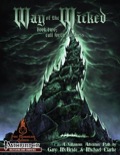
Way of the Wicked—Book #2: Call Forth Darkness (PFRPG) PDFFire Mountain GamesOur Price: $10.00 Add to CartExcellent, if your GM mojo is working and the PCs are willing . . .Call Forth Darkness is another solid adventure, although personally, I liked the opening installment just a bit better. The PDF, like it's predecessor, is beautiful. The layout, colors, and artwork continue to be very impressive. The Farholde Gazetteer in this book does a lot to bring the setting to life, which I think is important in an adventure path such as this one. The more the PCs realize that there is some history and culture behind the targets they eliminate, the more the fact that the PCs are villains is really brought home. The article on evil organizations and minions presents a subsystem for managing minions that I wish were available in slightly more generic form for non-evil groups that also have followers. It's nice to have some guidelines as to what all of those “not quite combatants” can do when you take the time to actually be a leader. An interesting addition at the end of the adventure is the exploration of other ways to structure the adventuring party and frame the AP based on specific themes (i.e. the whole party is clerics, the whole party are wizards, no one is a spellcaster) and what needs to be done to fit that theme. It's not overly detailed, but it's nice to see these musings and I'd like to have seen this kind of thematic conjecture in some of Paizo's adventure paths. Now, for the adventure itself. When I say I prefer the first installment, it's not a matter of quality. It's from the GM expectation point of view. This adventure could be great or it could nosedive, because while it is a brilliant premise and laid out about as well as you could for this kind of concept, it really depends on the PCs picking up the ball and running with it. That is true to an extent in the original adventure as well, but without a direct authority figure nudging them as much as they might have had in the first adventure, while the ultimate objective is clear, the compelling bit in the middle might not be as cool if the PCs don't get the vibe that the adventure is sending out (i.e. if they treat this as a dungeon to clear out rather than one to dominate). One last nit pick that I will try to throw out there without spoiling too much. I love the security point concept, but wish it did more than it does. The payoff isn't quite as tangible outside of the metagame rewards. All in all, recommended, and greatly recommended. Just pray that your players really relish being villains and not just evil characters. 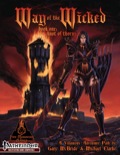
Way of the Wicked—Book #1: Knot of Thorns (PFRPG) PDFFire Mountain GamesOur Price: $10.00 Add to CartEvil is good!I wasn't sure what to expect with this product. It was a novel concept. I have to admit that I've been skeptical of evil campaigns before. But between the sales pitch and the buzz, I wanted to see what this was about. I'll get the cosmetic out of the way first. This book is pretty. There isn't a ton of art, but what there is is good, and fits the theme. The format, colors, and presentation all look really sharp. This is a first class production just based on looks. But to get to the crux of the matter, how is the adventure? It's great. The set up is fun, and there is a great sub-system that is simple but perfectly logical for resolving the final act of the adventure. The advice for evil campaigns is simple, but pretty logical, especially as applied to this campaign. There is a semi-random character generation method I'm not sold on, but the campaign traits are thematic and perfect to set the tone of the adventure. All in all, if you have ever been curious about how to set up an evil campaign to avoid the general pitfalls that might come about, this is definitely worth a look, even if you only use it as a model for your own ideas. The taxes in here are great, and a lot of them make perfect, logical sense to throw into a campaign. For the price, the extra details and idea starters are excellent. 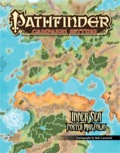
Pathfinder Campaign Setting: Inner Sea Poster Map FolioPaizo Inc.
Add
Folio
Add PDF $9.99 Non-Mint Unavailable If you are at all interested in the setting and have the cash . . .Before we started our game at the FLGS the night I picked this product up, we laid these out on the table and looked around the map. Not only did we find all sorts of interesting areas from APs and from Pathfinder Society adventures, it got us talking about the setting, about how traveling from one area to another influences things, what likely go traded with whom. I also got us talking about the "good old days" and some of the great maps that came with campaign settings of ages past. Its probably not a mandatory for running games in Golarion, but I have to say, if you have the cash its a great investment. These cards do exactly what they say they do . . . they have conditions on them, and its easy to look through the cards, find the condition, and hand it to a player so they don't keep flipping through their rulebooks. But more than that, every person I showed these to at the FLGS loved the goblin illustrations. So they do what they say they do, and they do it with style. I love simple templates, but I have to admit, the two that I get the most use out of, giant and advanced, can start to feel a bit overused. So when I saw this product, I was definitely interested. There are six templates in this product: Diamond (CR +2), Eternal (CR +2), Ghul (CR +2), Mighty (+5), Missing (+3), and Two-Headed (+1 or +2). All of the templates are interesting, although I'd have to say that Diamond and Ghul are my least favorite, not because either one of them is bad, per se, but they push the limits of my gut feeling of "simple." Diamond creatures are native to the elemental plane of earth, and ghuls have some really specific undead traits and abilities. Additionally, they are a bit more complicated than the other templates to apply. I say this only because the other templates tend to be very broad templates to do "something" to a monster, while the two listed above have more of a specific flavor to them. That having been said, if you every wanted quick rules to make a lot tougher version of monster (say you want a more powerful, "mythological" version of a classic monster), the mighty template looks to be great for this. The Eternal and Missing templates (one making a creature immortal and the other making something naturally invisible and displaced) look to be fun from all kinds of roleplaying standpoints. All in all, I'm pretty excited to find excuses to slap some templates on some standard monsters, and simple templates are great for tinkering. 
Gaming Paper: 1" Squares (Singles)Gaming PaperBackorder Combo $18.99 Backorder Blue $14.99 Backorder Cobblestone $14.99 Backorder Green $14.99
Backorder
White
Really easy to prep for my gameI used this to prep for my last two game sessions. I have to say that while I don't quite like the texture as much as the rolls, and I like the lighter blue for the lines, this stuff is so much easier to sit at my desk and drawn out rooms, even if I spread them out over a couple sheets. I bumped this a star because it feels a "little" pricey. Its not bad, and I get that this is a new product that takes more process than the rolls, but other than that, I'm pretty happy with this, and I'll be stocking this along with the rolls. I really don't have much to say that can't be gleaned from the other reviews. I'm not 100% sure all of these guys are winners (Cactus Golems are interesting, but they don't jump out for me to use them, for example), but there are a few I really want to use. Lower CR constructs are great as temple guardians, and the Void Golem alone is almost worth the cost of admission. In fact, the Void Golem is is probably my #1 vote for monster that I would love to see used in an official Pathfinder product right now. 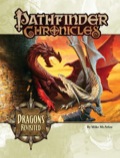
Pathfinder Chronicles: Dragons Revisited (OGL)Paizo Inc.Add Print Edition $19.99 Add PDF $15.99 Non-Mint Unavailable Wow, I feel really bad doing this . . .Honestly, its not a badly written book. Its not a bad looking book. But I'm not sure why you would need it. I'm not sure that the quirks that some dragons pick up (which are kind of fun in the case of black dragons, for example) make up for the status quo of most of the dragons. There are tons of references to a greater draconic culture, but very few specifics. I'd love to have seen a bit more information on the religions of Apsu and Dahak, but what you actually get is references to the two that assume you have other source material on them. Still, I'd probably have given this a solid three, if not for the things I think were the negatives in this book. There are places in this book where dragons are referenced as interacting with societies on as casual a level as elves or dwarves. It really makes them seem much less special and intimidating. Finally, the bit that really caused me to have fits with this book had to do with silver dragons. Essentially, silver dragons are the worst parody of every bad paladin stereotype ever. Honestly, I'm hoping over time the good parts of this book make it into other books, and the rest just kind of fades away. 
Pathfinder Chronicles: Cities of Golarion (PFRPG)Paizo Inc.Print Edition Unavailable Add PDF $15.99 Non-Mint Unavailable An excellent resource for the Golarion settingThis book does a very good job of fleshing out several cities in the Pathfinder campaign setting, and many of these cities also serve to give some additional flavor to the nations that they are associated with. The coverage of Cassomir is a perfect compliment to the Taldor: Echoes of Glory product, and immediately, perhaps more than any of the other cities, this one stands out in the product as being the best base for a "standard" adventuring party. On the other side of the coin, Nisroch doesn't seem like a place well suited for much except a destination for an adventure where the adventurers are quick to exit the scene once their mission is done. It doesn't run at maximum awesome. Corentyn is fine, but doesn't seem especially well suited for being called out in a product like this, as an example. Still, none of the write ups are bad, and the product as a whole is very solid. 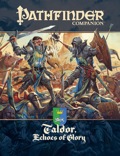
Pathfinder Companion: Taldor, Echoes of Glory (OGL)Paizo Inc.Print Edition Unavailable Add PDF $9.99 Non-Mint Unavailable Nice new perspective on Taldor without ruing what I already knew . . .There are lots of interesting points about Taldor in this book that detail the country for those that want more details. That's good, but it goes beyond that to explain where there are likely adventures, what kind of political maneuvering is going on, and how Taldans see the world around them. Reading this made me want to run a campaign in Taldor, and previously I viewed Taldor as that "past its prime" country. Its still, well, fading, but there is lots of life left in the place as an adventuring region. If you like "Sword and Castle" style fantasy, this is actually a really good area to run that kind of campaign. 
Pathfinder Player Companion: Adventurer's Armory (PFRPG)Paizo Inc.Print Edition Unavailable Add PDF $9.99 Lots of nice ideas and flavor . . .While the book has lots of nice idea for equipment, its got some serious strikes against it. 1. Errata in a book of equipment is a killer. Its not as big a problem when its some side issue, but the whole point of a book like this is stats, and there were too many mistakes on that front. 2. Format. This follows the standard format of Player's Companion books, which is odd for a book like this and causes you to have pages on an alchemist NPC that I really don't care that much about. 3. Some of the best stuff in here ends up in the Advanced Player's Guide as well. You may want to check and see if that stuff you really just have to have is reprinted there before picking this up. 
Pathfinder Chronicles: Faction Guide (PFRPG)Paizo Inc.Print Edition Out of print Add PDF $15.99 Non-Mint Unavailable Great for fleshing out power groups . . .This book has some great information for giving you some snapshot information of various power groups in the campaign setting, without getting too in depth, so that players can get a taste for them. The faction point system seems to work well, and is pretty much the same one that is in effect in PFS organized play. My biggest concern is that too many factions in the guide have rewards that have to do with granting followers, which can be a pain for a GM that doesn't quite know what to do with those extra bodies, especially when some of them are implied to being active participants in adventures (like bodyguards) instead of just non-combatants for roleplaying purposes (which some of them are). 
Pathfinder Roleplaying Game: Advanced Player's Guide (OGL)Paizo Inc.Add Hardcover $44.99 Add PDF $19.99 Non-Mint Unavailable I really try to be objective . . .Wow was this book amazing. If there is any problem I have with it, its probably some of the redundancy with items presented in this book that were also in the Adventurer's Armory, but they all make sense to put in this book. When it comes to the archetypes, I have to say that anywhere a similar option is presented to something that was done in 3.0 or 3.5, such as a blight druid or a spell less ranger, I like the options in the APG better, and the option seems to flow a lot more naturally. I did deduct one star from this product because in at least one case (one of the paladin archetypes), the errata seems to a whole new restriction on an ability rather than simply clarifying how it works. I hate errata that rewrites whole sections of rules instead of clarifying or just adding a word or two . . . if this product wasn't so solid nearly everywhere else, it probably would have cost my review more than one star. Books like this really make me less and less concerned about phasing out some of my 3.5 material, as these options seem to play much nicer with my style of play. 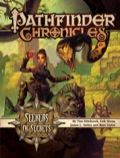
Pathfinder Chronicles: Seekers of Secrets—A Guide to the Pathfinder Society (PFRPG)Paizo Inc.Print Edition Out of print Add PDF $15.99 Non-Mint Out of print Solid book, mostly focused on background information . . .I remember early on in the Pathfinder Society Organized Play circles, finding out what ioun stones did with wayfinders was a big deal. Strangely, that mystery seemed less important by the time this book came out, but the explanation was still a lot of fun. While there are some very useful spells, magic items, and gear in the book, this is mainly a book to explain the history and mindset of the Pathfinder Society. While it would be very nice if people interesting in playing Pathfinders would get a feel for the organization, if someone isn't the type of player to care about that, they aren't really going to get that much out of the book. Still, if you want to know how you may have been trained, how the organization started, what the lodges look like, and what the current clack within the Society might be, this is a good book to pick up. The book does seem to meander a bit when it comes to describing how Pathfinders view different regions of the setting, because there seems to be little difference between what Pathfinders see in a region and what general adventurers see in that same region. 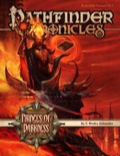
Pathfinder Chronicles: Book of the Damned—Volume 1: Princes of Darkness (PFRPG)Paizo Inc.Print Edition Unavailable Add PDF $15.99 Non-Mint Unavailable Really nice book on the underpinnings of evil in the campaign . . .This book has some very nice background material on Hell in the Pathfinder setting, as well as information on the ruling beings of Hell, its layers, and how it works. Reading through the book makes you really want to find a way to work this information into your campaign. There are disturbing planar cities as well as interesting sites and terrain. Not only is all of that in place, but the PFRPG rules in the book are a good support to the information, such as the Diabolist PrC, and the rather nasty spells and monsters in the book. One of the things I really like is that the secret events of the beginnings of the universe MAY be explained, but may not, depending on how reliably you adhere to the source of the information. Wonderful way to expand large scale setting information of this sort. The Armiger is an interesting class. The concept is a neat one, that being that its a combat class that is all about maximizing defensive capabilities. The class has a d12 hit dice and a medium BaB . . . it gets talents at various levels, and it has DR whenever the character has armor on, and can do things like granting cover to adjacent foes. I really, really want to like this class. I like the concept. But I have a hard time with the various, and I mean various, deviations from Pathfinder standard rules. A lot of times, I know that SGG pushes the boundaries and sees what works. I appreciate that, and sometimes I don't always agree, but I understand and think the experimentation is a good thing. This class has medium BaB with a d12 hit dice (one deviation)and treats any hit points rolled on their hit dice under a 6 as a 6 (meaning they get a minimum of 6 hp per hit dice no matter what). . . I'm not quite thrilled with those deviations from "Pathfinder RPG Norm". The core conceit of the class is to twist and break the standard rules to attempt to make sure the class always has more hit points than anyone else. That doesn't feel like a strong basis for a class. Sorry guys . . . I still love you for trying though! Also, I amended a bit of the review as I misinterpreted a rule on my initial run through, and a mistake was corrected in the PDF in the meantime. 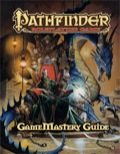
Pathfinder Roleplaying Game: GameMastery Guide (OGL)Paizo Inc.Hardcover Unavailable Add PDF $19.99 Non-Mint Unavailable You Know, I Don't Give These Out OftenThis book is absolutely amazing. If you think you already know the advice in this book, you are probably right, but honestly, its not the words, but the presentation. You'll want to remind yourself why some of this stuff is the sort of thing you should be doing when you run your game. The NPC, Campaign, and Settlement tracking sheets are amazing, not because they have brand new things you have never thought of on them, but because they are put together in a great format to make you want to use them. The NPC Gallery alone is worth the price of admission, and I have to say, its much more useful than the old NPC stats in the 3.5 DMG, since these characters are built not to be a generic member of a class at X level, but rather these are characters to fit a theme (pirate, adventuring wizard, tomb raider, etc) The optional rules, such as insanity, chase rules, and haunts, are great GM resources. I could go on and on, but honestly, this is just a great collection of tools and advice for any GM. You can't go wrong, and you may want to use things like the Campaign sheet or the NPC sheet no matter what game you are playing. A good solid selection of combat oriented feats. I like the prerequisites of not having any caster levels for some of these. We haven't seen that before, but it doesn't "feel" wrong to me either. Nice feats for dealing with several of the headaches that front line warriors have to deal with, such as running screaming from a fight or getting their rear ends handed to them by spells targeting their "bad" saves. Also a nice few feats for building a swashbuckler, and monks get a nice "Jedi" option for their deflection abilities . . . ;) Its probably no surprise that I'm not a fan of Battle Mage, due to its extra sub-system that it introduces, and I have a hard time really liking Layered Armor, but beyond that, its a really nice collection of feats. One of the reasons I really like the Genius Guides is that I'm the kind of GM that would rather allow a source as a whole, rather than picking apart what I would allow here or there. So having a "themed" smaller product is really good for my mindset. First off, I really like most of these feats. None of them strike me as being over powered, and for the most part, they strike me as being in line both in power and "feel" with Pathfinder core material. Where I'm a little iffy are the Subtle, Surprise Attack, and Trickster Mage feats. The first two are things I'm not so sure I wouldn't just allow someone to do without a feat under the right circumstances. Trickster Mage is one of those things that creeps up once in a while that feels a little too complex and outside of the Pathfinder standard for me to be comfortable with. Its not overpowering, its just that it introduced a sub-system when you take the feat, as well as having a more complicated system for spontaneous casters using the feat than prepared casters. Overall, a solid work, with the exceptions that I mentioned above, which may not bother other people at all. The price is great, so I can't really tell anyone that this one is too expensive to check out and evaluate for yourself. 
The Noble Wild: An Animal Player’s Handbook for Fantasy Role-Playing Games (PFRPG)Skirmisher PublishingOur Price: $16.99 Add to CartA very interesting toolboxI wouldn't suggest using everything in the book and dropping it into just any campaign, but the concept is so broad and interesting that its pretty easy to use piecemeal in a lot of campaigns. If you have a unique animal that is intelligent, and you want to give it class levels, you are covered. If you want to go the full Monty and run a Narnia style campaign with full on intelligent animals as common as other intelligent races, or if you want your Faerie realm populated with intelligent animals, you have more than enough information for that too. As an example of what I mean by using things piecemeal, the first part of the book deals with the stats that animals have compared to other races. You can use this easily with the normal rules and make up a character. If you want to, you can use the information on separate magic for animals and other races and blood magic, but you can also just use the animals as is for their statistics. One of the first things that this product made me think of was going back to the 1st edition concept of reincarnation allowing for animal reincarnations, and another concept that this book helps to support is the idea of awakening an animal and using it as a cohort for someone in the party. That having been said, for what might be a niche campaign, its a sizable investment. Not that its not well done, or fun to read, but its not something that will appeal to everyone ( . . . says the man whose wife has often said she hates any "talking animal" fantasy stories). If you are really interested in how you might play animals as viable characters in a Pathfinder RPG campaign, its really well done and worth a look. If you are just looking for more general campaign information, or more on "standard" animals, its might be a bit too much of a "fringe" product for what you are looking for. The concept of elf/oni is kind of cool. Its also not something that seems like it would be common. The support material for this races, including a PrC and a Paragon class, are really solid. I really liked that this was reworked as a standard race instead of trying to shoehorn the original +6 LA race into Pathfinder. That having been said, with a strong Asian flavor and a hard origin to make common, these guys aren't going to be easily dropped into just any campaign, unless you are making a PC or NPC that just happens to be a unique being, but then you lose out on using a lot of the strong background material. If you have an "unexplored land" that might work for the origin of this race, it may not be quite as hard to use them. But if too much is established about how common Oni are and where and how elves interact with others, its a little trickier. Despite that, its a good read, and its interesting enough that the material at least makes you want to try to make them fit into a campaign, because its such a unique concept and so well realized and fleshed out here. Take my three stars as more of a measure of general utility rather than specific quality. Its solid design and a satisfying read. I love giants. I'm not sure why. They seem like a very simple type of monster, and yet I love them. Maybe its the association with Norse and Celtic myths that draw me to these guys. What you get with this product isn't a race, but actually a race and a hybrid race/class. If you play the "stunted" version of the race, you are essentially a humanoid with a powerful build that has a giantish lineage. To me this works very well for a Celtic or Norse themed game. On the other hand, if you don't play "stunted" version of the class, you have to take the paragon class, which essentially allows you to customize your character into one of the more traditional giant types, over time. Essentially you are from a race of giants that kind of has the potential to be any other type of giant. There are a couple of minor, but understandable, aspects of this product that keep me from rating it higher. I understand from the mechanics viewpoint why a character that isn't "stunted" is locked into the Paragon Class, but the "fluff" part of it just doesn't work as well for me as it could. I'm not quite sure why, but the "advance or die" reasoning isn't as satisfying as it could be. Also, while it doesn't bother me to end up as a Huge frost/fire/stone giant, if I'm playing this class to emulate one of the "smaller" giant races, I'm not sure I'm as thrilled with playing a gargantuan or colossal giant. Those certainly aren't game breakers for me, however, and the temptation of playing pretty much any type of giant with lots of "extra" thematic powers via the paragon class, and the added benefit of being able to just play a "giant-blooded humanoid" if I don't want to get into that class, this is a solid offering for me, and since giants are pretty much a standard for most campaigns, a pretty easy concept to slot into a campaign.
|
|






